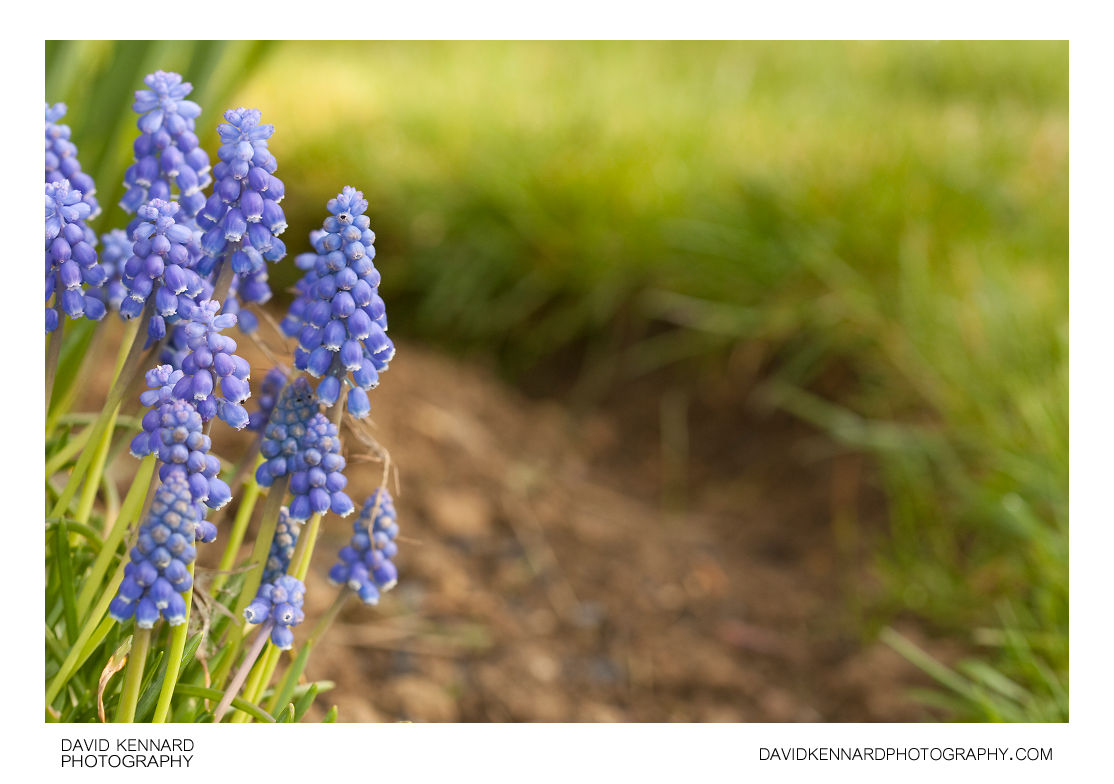Grape Hyacinth (Muscari)

Description
- Title:
- Grape Hyacinth (Muscari)
- Caption / Description:
-
The genus Muscari, commonly and collectively known as grape hyacinths, are a group of perennial plants native to Eurasia that produce urn-shaped spikes of dense, most commonly blue, flowers resembling bunches of grapes in the spring. White cultivars also exist.
Classified as being in the family Hyacinthaceae, they have also been placed amongst the Liliaceae as a member of the Hyacintheae tribe. There are about forty species. These are subdivided into subgenera e.g Botryanthus.
Some species are among the earliest to bloom in the spring. They are planted as bulbs and tend to multiply quickly (naturalise) when planted in good soils. They prefer well drained sandy soil, that is acid to neutral and not too rich. May be found in woodlands or meadows, they are commonly cultivated in lawns, borders, rock gardens and containers. They require little feeding or watering in the summer, and sun or light shade.
Muscari comosum bulbs are pickled and eaten in Greece under the name βολβοί ([vol'vi] lit. 'bulbs') and in the Basilicata and Puglia region of Italy, under the names "lampascioni", "lampasciuni", "lamponi". They are included in the Ark of Taste catalogue of heritage foods.
The Muscari have originated in the old world, from the Mediterranean basin, the Center and South of Europe, Northern Africa, the West, Center and South-West of Asia. The term muscari comes from the Latin muscus, since the scent is said to resemble musk.
Description from Wikipedia: http://en.wikipedia.org/wiki/Grape_hyacinth
- Tags / Keywords:
-
- Biota
- Life
- Vitae
- Eukaryota
- Grass
- Green
- Purple
- Plantae
- Plants
- Magnoliophyta
- Flowering Plants
- Angiosperms
- Liliopsida
- Monocotyledons
- Asparagales
- Violet
- Garden
- Hyacinthaceae
- Muscari
- Grape Hyacinth
- Borders
Admin
- Date Original Photo Taken:
- Original File Name:
- _MG_8483.CR2
- Event:
- Rating:
- ☆
- Date this image added/last updated on website:
- Original File Dimensions:
- 4272px x 2848px
- File Type:
- JPEG
- Color Mode:
- RGB
- Original Image Color Profile:
- Adobe RGB (1998)
Location
- Location Created:
-
- Sublocation:
- City:
- Market Harborough
- Province/State:
- Leicestershire
- Country:
- United Kingdom
- World Region:
- Europe
- Geo-location:
Rights
- Copyright Status:
- Copyrighted
- Licensing Status:
- Rights Managed
- Available for Editorial Use:
- Yes
- Available for Commercial Use:
- Yes
- Copyright Notice:
- © 2010 Dave Kennard
Camera Data
- Date Digital Resource was created:
- Shutter speed:
- 1⁄200 s
- Aperture:
- f/5.6
- Camera Model:
- Canon EOS 450D
- ISO:
- 400
- Exposure Compensation:
- 0
- Focal Length:
- 100mm
- Focal Length (35mm equiv.):
- Metering Mode:
- Multi-segment
- Flash:
- On, Fired
- Exposure Mode:
- Manual
- White Balance:
- Manual
- Light Source:
- Exposure Program:
- Manual
Additional shooting metadata
- Lens:
- Canon EF 100mm F2.8 Macro USM
- Filters used:
- Additional Optics used:
- Setup:
- Handheld
Canon MT-24EX Macro Twin Flash with home-made diffusers
Post Processing
- Image Modified:
- Software used:
-
- Adobe Camera RAW
- Post Processing:
-0.25 exposure compensation in ACR
